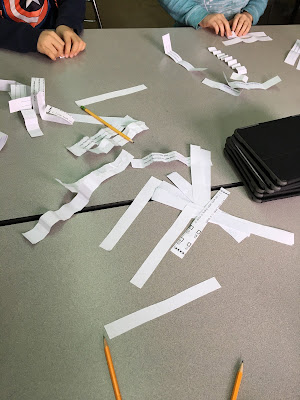My Favorite Fraction Manipulative
Wait, that just looks like strips of paper?!
Yep, that's what it is. Introducing my FAVORITE fraction manipulative. No need for fancy plastic fraction tiles, no purchase order necessary, no app to download. Just find some paper and cut it in strips. It can even be "GOOSe" paper (good on one side), as in scrap paper!
Here's why I love it:
1) It makes fractions visual.
2) It relates to tape diagrams.
3) It helps make connections of where fractions go on the number line.
4) It's a manipulative that won't expire. It always works, even when students start exploring decimals and percents.
5) It's fun!
I have done this lesson with lots of kids over the years. It works great with grades 4-6.
Here's the procedure:
1) Put a lot of strips of paper out! (you want kids to have access to extra in case they "mess up")
2) Have students start with 1 strip and fold into halves. This is usually accessible for all kids. But walk around to help if anyone is stuck (although use questions to nudge thinking forward instead of showing them what to do!)
3) Address the "hamburger" vs "hotdog" way of folding. For this activity we want all of our folds to go vertically and there are always a few kids that think a little differently and might want to fold the "long way."
4) Next challenge, grab a new strip and try fourths! This is the time to talk about how all segments need to be equal in size (most don't have issues now, but might as the fractions get harder).
5) This is a good spot for a little prediction. Ask students what do they think will happen if they take their fourths, folded up so 1/4 is showing, and fold that in half. I've noticed a split between kids thinking it will make 6 segments and kids that think 8. I like to ask kids, "What pattern might someone be thinking about if they think it will be 6?" (answer: they are probably thinking 2, 4, 6...) What pattern are they thinking about if they predict 8? (answer: doubling 2, 4, 8...)
6) Fold and see what happens! It's eighths!
7) Next, new strip and try thirds. This is surprisingly tricky for kids. They might need a few strips to get it right. Students might make 3 sections that aren't equal, so watch for that. It's common for me to see students with 3 sections (1/2, 1/4, 1/4). If students are really struggling after a few tries, you can give them some hints about how they might make it work (I give a "S" strategy that works for most)
8) As kids get thirds, I let them try fifths, and if they do that I challenge them to try twelfths. At this point kids are in all different places, and that is okay. Everyone is working on something that is a good challenge for them!
Extra teacher tips:
-Remember that discovery and mistakes are part of this process. Don't be too helpful!
-Keep that neutral, non-judgemental tone. Mess up a strip? No prob, grab another and try again.
-Walk around and observe. What do you learn about your students by watching them do this activity? What math do they know? What understandings do they already have? What should be your next steps? How do they handle making a mistake? How do they help each other?
-Understanding fractions is a progression. Have you watched this from Graham Fletcher yet? You need to!
Ideas for next steps:
-think about having students use the strips to help them locate benchmark fractions on a clothesline number line. (Check out the pic above. This group of students placed 1/4 between 1/2 and 1, so there is some unfinished learning there)
-leave strips of paper accessible to students to use throughout the fraction unit (or the whole year!). Any time there is a question or a student is struggling with something, refer them to the strips and see if they can make a fraction strip to help them reason through it.
-consider extending the activity and have students show what they know by creating something. I had my 6th graders make stop action videos! It really helped them think through the process.









Comments
Post a Comment